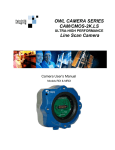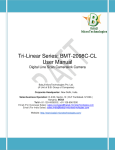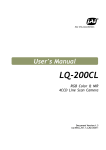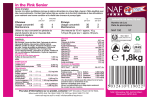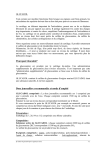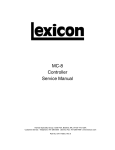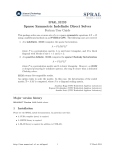Download Fairchild CAM/CCD-2KCL.TDI User's Manual
Transcript
OSPREY CAMERA SERIES CAM/CCD-2KCL.TDI CAM/CCD-4KCL.TDI ULTRA-HIGH PERFORMANCE With CameraLinkTM Fairchild Imaging • CAM/CCD 2KCL.TDI & CAM/CCD-4KCL.TDI Line Scan Camera User’s Manual • Rev C• 1 of 30 EMC Conformance This equipment has been tested and found to comply with the limits for a Class A digital device, pursuant to Part 15 of the FCC Rules. This product fulfills the following requirements of the standards and carries the CE marking. EMC: FCC Part 15, Subpart B EN 6100-6-4:2001 EN 6100-6-2:2001 EN6100-3-2:2000 EN 6100-3-3:1995/A1:2001 Fairchild Imaging • CAM/CCD 2KCL.TDI & CAM/CCD-4KCL.TDI Line Scan Camera User’s Manual • Rev C• 2 of 30 FAIRCHILD IMAGING OSPREY CAMERA SERIES USER’S MANUAL CAM/CCD-2KCL.TDI & CAM/CCD-4KCL.TDI Revision B December 14, 2004 © 2004 Fairchild Imaging, Inc.. PRELIMINARY DOCUMENT The information in this manual is preliminary. All information provided in this manual is believed to be correct at the time of writing. No responsibility is assumed by Fairchild Imaging for its use. Fairchild Imaging intends to make this manual as accurate as possible and reserves the right to make changes to this information without notice. Fairchild Imaging, Inc. 1801 McCarthy Boulevard Milpitas, CA 95035 phone 800-325-6975 fax 408-435-7352 www.fairchildimaging.com Fairchild Imaging • CAM/CCD 2KCL.TDI & CAM/CCD-4KCL.TDI Line Scan Camera User’s Manual • Rev C• 3 of 30 Table of Contents SECTION I Introduction to the CAM/CCD-2KCL.TDI & CAM/CCD-4KCL-TDI High Performance TDI Line Scan Camera..................................................................... 6 1.1 Camera Highlights...................................................................................................... 6 1.2 Camera Specification ................................................................................................. 8 1.3 Image Sensor ............................................................................................................. 9 1.4 Block Diagram CCD525 ............................................................................................. 9 1.5 Block Diagram CCD545 ............................................................................................. 10 1.6 2K/4K TDI Camera Timing Diagram........................................................................... 11 1.7 Thermal Considerations ............................................................................................. 12 SECTION 2 Camera Hardware Interface............................................................................................ 13 2.1 Installation Overview .................................................................................................. 13 2.2 Connectors, Pinouts and Cables ................................................................................ 14 2.3 Power Supply ............................................................................................................. 15 SECTION 3 Camera Control ............................................................................................................... 16 3.1 Quick Start with the CameraLink Interface ................................................................. 16 3.2 Camera Control Signals using Camera Link Interface................................................ 16 3.3 Serial Communication ................................................................................................ 16 3.4 Commands ................................................................................................................. 16 3.5 Camera Command Summary..................................................................................... 20 3.6 Framing Mode ............................................................................................................ 21 SECTION 4 Mechanical and Optical Considerations ....................................................................... 22 4.1 Camera Dimensions and Mounting Facilities ............................................................. 23 4.2 Lensing....................................................................................................................... 23 4.3 Mechanical Drawing of Available Camera Face Mounting “L” Bracket ...................... 24 4.4 Lenses........................................................................................................................ 25 4.5 Illumination ................................................................................................................. 25 4.6 Light Sources ............................................................................................................. 25 SECTION 5 Handling Instructions 5.1 Electrostatic Discharge............................................................................................... 26 5.2 Preventing ESD Damage ........................................................................................... 26 5.3 Protecting Against Dust, Oil and Scratches................................................................ 26 5.4 Cleaning the Sensor Window ..................................................................................... 26 Fairchild Imaging • CAM/CCD 2KCL.TDI & CAM/CCD-4KCL.TDI Line Scan Camera User’s Manual • Rev C• 4 of 30 SECTION 6 Troubleshooting .............................................................................................................. 27 6.1 Check Simple Things First ......................................................................................... 27 6.2 General Solutions....................................................................................................... 27 SECTION 7 Product Support .............................................................................................................. 30 Fairchild Imaging • CAM/CCD 2KCL.TDI & CAM/CCD-4KCL.TDI Line Scan Camera User’s Manual • Rev C• 5 of 30 SECTION 1 Introduction to the CAM/CCD-2KCL.TDI & CAM/CCD-4KCL.TDI High Performance TDI Line Scan Camera 1.1 Camera Highlights Description The Osprey TDI camera series is an ultra-sensitive camera design for use in line scan applications that demand high performance under low light conditions. This series of cameras is based upon Fairchild’s CCD525 array, which is used in the very successful U.S. Postal Service Wide Field of View (WFOV) Camera. The 2K camera versions have 2048 pixels in the cross-scan direction, with selectable TDI stages up to 96 rows. The 4K varieties have 4096 pixels in the cross-scan direction, also with selectable TDI stages up to 96 rows. The 2K Osprey supports scan rates up to 46K lines per second while the 4K yields up to 23K lines per second. Both the 2K and 4K styles have a CameraLinkTM output. The CameraLinkTM output supports 4-port, 8-bit synchronous data. These cameras also include sophisticated features such as anti-blooming, programmable gain and offset. They are packaged in a very compact and rugged housing that contains a standard M58 x 0.75 base lens thread. Optional (Nikon-F) lens adapter is available. 2K x 96 TDI Sensor Architecture • • • • Uses time delay and integration sensor architecture User selectable TDI lengths of 96, 64, 48, 32, 24 Line rate up to 46K lines per sec 1000X antiblooming 4K x 96 TDI Sensor Architecture • • • • • Uses time delay and integration sensor architecture User selectable TDI lengths of 96, 64, 32, 16, 4 25MHz pixel clock Non volatile gain/offset value memory 1 LSB Noise RMS Fairchild Imaging • CAM/CCD 2KCL.TDI & CAM/CCD-4KCL.TDI Line Scan Camera User’s Manual • Rev C• 6 of 30 Programmability • • Simple menu-based configuration for selection of gain, calibration, test patterns operational control, and diagnostics CameraLinkTM camera-PC communications Usability • • • • Programmable gain, offsets, and controls Internal flat field correction Easy integration “plug compatabile” CameraLinkTM hookup Exposure control Full Spectrum of Applications • • • • • Precision manufacturing inspection Web inspection Sorting and routing Biomedical readout systems Diagnostic systems Fairchild Imaging • CAM/CCD 2KCL.TDI & CAM/CCD-4KCL.TDI Line Scan Camera User’s Manual • Rev C• 7 of 30 1.2 Camera Specification: CAM/CCD-2KCL.TDI & CAM/CCD-4KCL.TDI Performance Specification 2048 Calibration Conditions Units Min. Data Rate (Strobe) MHz Line Rate (LVAL) KHz 0.3 Units Min Functions 4096 Typ. Max. 25 25 Min 46.0 0.3 Typ Max Min Typ. Max. 25 25 Notes 23 8 Typ Max Notes Saturation Output Amplitude DN 250 255 250 255 Output Gain Mismatch DN 2 5 2 5 Pixel Response Non-Uniformity Global DN 5 12 5 12 (PRNU) Tap DN 4 10 4 10 1, 3,4 Pixel-Pixel DN 4 10 4 10 7 Global DN 3 3 3,4 Tap DN 2 2 1, 3 Pixel-Pixel DN 2 2 3, 4 DC Offset DN 4 4 2 DC Offset Mismatch DN 2 2 Random Noise DN Fixed Pattern Noise (FPN) 2 4 2 4 Noise Equivalent Exposure pJ/cm 2 1.2 3 1.2 3 Saturation Equivalent Exposure nJ/cm 2 .8 1.0 .8 1.0 Responsivity DN/(nJ 2 /cm ) Dynamic Range Power Supply Current @ 12VDC Ratio 250 600:1 mA Power Supply Voltage Volts Operating Temperature °C First Pixel Mismatch DN 250 600:1 400 10.5 12 15.0 10.5 40 Notes: DN = Digital Numbers, also known as “levels” (0 – 255 for 8-bit systems). All measurements taken with camera operating in 96 stage mode. All measurements exclude the last pixel of OS 1 and the first pixel of OS4 1. Measured across 1 tap (512 pixels) or (1024 pixels) 2. Typical offset @ 20°C ambient 3. Excludes last pixel of OS1 and first pixel 4. Measured across all taps. 5. Measured on each tap relative to next ten pixels. Measured at Vsat. 6. Measured with digital outputs, terminated. 7. A delta window of 8 pixels is examined and shifted by half its window. excluded from each tap. 8. Camera will operate below min. line rate with degraded performance. 420 6,9 12 15.0 40 5 First and last pixel Fairchild Imaging • CAM/CCD 2KCL.TDI & CAM/CCD-4KCL.TDI Line Scan Camera User’s Manual • Rev C• 8 of 30 1.3 Image Sensor The family of Osprey cameras use the following Fairchild sensors. The 2K x 96 TDI camera uses the CCD525 sensor and the 4K x 96 TDI camera uses the CCD545 sensor. Both sensors have 13µm square pixels on a 13µm pitch with 100% fill factor. Both the CCD525 and CCD545 sensors have been designed with improved blue response. Both sensors are much more sensitive than single line CCDs used in line scan cameras. 1.4 Block Diagram CCD525 2048 x 96 stages Fairchild Imaging • CAM/CCD 2KCL.TDI & CAM/CCD-4KCL.TDI Line Scan Camera User’s Manual • Rev C• 9 of 30 1.5 Block Diagram CCD545 4096 x 96 stages Fairchild Imaging • CAM/CCD 2KCL.TDI & CAM/CCD-4KCL.TDI Line Scan Camera User’s Manual • Rev C• 10 of 30 1.6 2K/4K TDI Camera Timing Diagram TM TM 4K TDI CameraLink Strobe Period :40 nS Strobe Period :40 nS LVAL Set –Up Time :20 nS LVAL Set –Up Time :20 nS Line Period :20.48 µS Line Period :40.96 µS Blanking :1.8 µS Blanking :1.8 µS ExSync min Set – Up :650 nS ExSync min Set – Up :650 nS 2K TDI CameraLink ExSync min pulse Width :1.8 µS ExSync min pulse Width :1.8 µS Fairchild Imaging • CAM/CCD 2KCL.TDI & CAM/CCD-4KCL.TDI Line Scan Camera User’s Manual • Rev C• 11 of 30 1.7 Thermal Considerations The Osprey camera series has been carefully designed to separate the camera electronics from the image sensor. Fairchild Imaging advises that if you are going to do any gain or offset corrections that you perform these functions after the camera has been turned on for at least 15 minutes. To do offset correction, cover the lens with your lens cap and to perform a gain calibration, make sure that you have a good light source. Try to avoid excess temperatures in the ambient around the camera. Fairchild Imaging • CAM/CCD 2KCL.TDI & CAM/CCD-4KCL.TDI Line Scan Camera User’s Manual • Rev C• 12 of 30 SECTION 2 Camera Hardware Interface 2.1 Installation Overview Before you integrate your camera into your system you should first determine some basic operating parameters such as what resolution you need. Do you know the speed of the object that your camera will be inspecting? One additional point you want to keep in mind is your lighting requirement. Some other major items that you should identify early on in developing your system is the source of your EXSYNC control signal (framegrabber, custom controller, shaft/web encoder, etc.). You should also know—in advance—your sensor resolution and magnification requirements. We will use a simple example to reinforce what we just told you in the above. Let’s say that you have the following system to set up: inspect a web 10cm wide, moving at 2m/s, and you want 100µm on the web to be represented by one pixel (13µm). Number of Pixels Necessary Total width of image = Desired resolution 10 cm 100µm per pixel = 1000 pixels Magnification Pixel size Desired resolution = 13µm 100µm per pixel = 0.130 EXSYNC Web speed Desired resolution = Shaft Encoder Circumference You require one pulse for every 100µm of object travel. Assuming a shaft/web encoder = 0.10m Producing 1000 pulses/rev., shaft Circumference must be 1000 x 100µm 2m/s 100µm = 20KHz Remember, TDI cameras require PRECISE synchronization with the object velocity! (See example images below.) Good TDI Synchronization Bad TDI Synchronization Fairchild Imaging • CAM/CCD 2KCL.TDI & CAM/CCD-4KCL.TDI Line Scan Camera User’s Manual • Rev C• 13 of 30 2.2 Connectors, Pinouts, and Cables Figure 2.2-1 TM MDR-26 CameraLink Connector 3M p/n 334 – 34 series Table 2.2-1 Camera Pin # 1 14 2 15 3 16 4 17 5 18 6 19 7 20 8 21 9 22 10 23 11 24 12 25 13 26 Frame Grabber Pin # 1 14 25 12 24.0 11 23 10 22 9 21 8 20 7 19 6 18 5 17 4 16 3 15 2 13 26 Channel Link Signal Inner shield Inner shield X0 X0+ X1X1+ X2X2+ Xclk Xclk+ X3 X3+ SerTC+ SerTCSerTFGSerTFG+ CC1CC1+ CC2CC2+ CC3CC3+ CC4CC4+ Inner shield Inner shield Fairchild Imaging • CAM/CCD 2KCL.TDI & CAM/CCD-4KCL.TDI Line Scan Camera User’s Manual • Rev C• 14 of 30 Notes: • • • Exterior overshield is connected to the shells of the connectors on both ends. 3M part 14X26-SZLB-XXX-0LC is a complete cable assembly, including connectors. Unused pairs should be terminated in 100 ohms at both ends of the cable. 2.3 Power Supply The camera uses a single voltage input, normally set to 12 Volts @ 0.45 Amps typ. Ripple and noise is required to be < 20 mV RMS. Power is supplied through a Hirose connector. When installing the mating connector, be sure to line up the slots. This action will assure that you will not bend any of the pins. Hirose HR25-7TR-6P Receptacle Pin # Description 1 +12V 2 +12V 3 NC 4 GND 5 GND 6 NC Fairchild Imaging • CAM/CCD 2KCL.TDI & CAM/CCD-4KCL.TDI Line Scan Camera User’s Manual • Rev C• 15 of 30 SECTION 3 Camera Control 3.1 Quick Start with the CameraLinkTM Interface Follow your Frame Grabber manufacturer’s instructions when inserting the frame grabber card into your PC. Be sure that you install the correct configuration software that matches the camera you are using. At this point your camera should already be connected to the DC power supply and connected to the frame grabber in your PC. To communicate with your camera we have created specific commands. In the next section we will go over these commands in detail. 3.2 Camera Control Signals using Camera Link™ Interface Four LVDS pairs are reserved for general-purpose camera control. They are defined as camera inputs and frame grabber inputs. In the case of Fairchild Imaging’s CAM/CCD2KCL.TDI and CAM/CCD-4KCL.TDI cameras the signals are: Line Sync (generically Camera Control 1, CC1) Frame Sync (generically Camera Control 2, CC2) Spare, unused (generically Camera Control 3, CC3) Spare, unused (generically Camera Control 4, CC4) 3.3 Serial Communication The serial interface for the camera has the following characteristics: default baud rate 38400, one start bit, one stop bit, no parity, and no handshaking. 3.4 Commands Note: Commands are not case sensitive. To input commands, type in the three character command and hit enter. Command Syntax: Command + enter, example: Type in RSH, then enter Command + enter + value, example: Type in SSM then enter, then type 2 Command + enter + value + enter, example: Type in SLR then enter, then type 2000, then enter Fairchild Imaging • CAM/CCD 2KCL.TDI & CAM/CCD-4KCL.TDI Line Scan Camera User’s Manual • Rev C• 16 of 30 RSH This command allows you to perform a hard camera reboot. The camera returns … Reboot Started RSS This command allows you to perform a logic reset. No return………..no message INQ This command will show you what camera is connected to your PC. The camera returns … Fairchild Imaging 2K TDI Camera Link Fairchild Imaging 4K TDI Camera Link VER This command will show you the current software version in your camera. The camera returns … FPGA REV.2.5 Micro rev. 0.90 Prod rev. A 1.01 SLR This command allows you to set line rate, enter value and enter The range for line rate should be 2K 45000 – 25; 4K 23800 - 25 CPO This command allows you to Calibrate Pixel Offset (2K camera only). You must cover lens when performing this operation! This command allows you to calibrate pixel offset. You can observe this command by the blinking green/amber LED. When the LED stops blinking, that means that the calibration of the pixels is completed. CPG (2K camera only) This command allows you to Calibrate Pixel Gain. We strongly recommend that this command be done after each CPO. To perform this operation correctly the camera must look at a uniform illuminated light source. The LED will be a blinking amber/red. VOM This command reads the different component voltages located within the camera. The camera returns … 5.2VD = 5.2 3.3VD = 3.3 3.0VD = 3.0 1.5VAD = 1.5 Fairchild Imaging • CAM/CCD 2KCL.TDI & CAM/CCD-4KCL.TDI Line Scan Camera User’s Manual • Rev C• 17 of 30 TSB This command reads the internal camera temperature. The camera returns … Temp 39.42°C (example) SSM This command allows you to set the Sync mode. When selecting the option you need, first type SSM and press enter and then enter the appropriate single digit number, and then press enter. Value 1 2 3 4 Function Free Run Frame Mode Line Sync External Line Sync, Frame Mode SCM This command allows you to select a correction mode. When selecting the option you need, enter the appropriate single digit number and then hit enter. Value The camera returns … 1 2 3 4 5 6 Function M1 (1st memory) M2 (2nd memory) Offset Correction Gain Correction No Correction Full Correction STP This command allows you to select a test pattern. When selecting the option you need, enter the appropriate single digit number, and then hit enter. Value Function No output from camera… 1 2 3 4 5 6 Other Horizontal Ramp Vertical Ramp Vertical Stripes and Ramp Open 4096 0 Video Fairchild Imaging • CAM/CCD 2KCL.TDI & CAM/CCD-4KCL.TDI Line Scan Camera User’s Manual • Rev C• 18 of 30 CBR This command allows you to change the Baud Rate. You will not see anything on your monitor. Here is a table of stored rates in the camera…Value Function 1 2 3 4 5 9600 19200 38400 (Default) 57600 115200 If you can’t resist changing the baud rate, select the appropriate single digit number and hit enter. LED This command allows you to change the color. When selecting the option you need to, enter the appropriate single digit number and hit enter. Your screen will be blank during this command. You can input one of the following: Value Function 0 1 2 3 Amber Green Red Off SAP Store in Flash both correction memories, all registers and DAC values. Value Store all parameters 0 1 2 Function Default factory calibrate User User The power on values will be the last saved from SAP (X). RAP Load from flash to camera. Recall all parameters Value 0 1 2 Function Default factory calibration User User SBS Value Set bit shift 0 1 2 Function 10 bit 9 bit 8 bit Fairchild Imaging • CAM/CCD 2KCL.TDI & CAM/CCD-4KCL.TDI Line Scan Camera User’s Manual • Rev C• 19 of 30 SON Adjust video offset channel 0-3 value 0 – 255 Adjust video offset all channel value value 0 – 255 SOA SGN Adjust video gain channel 0-3 value 0 – 1023 Adjust video gain all channel value 0 – 1023 SGA TDI Set number of TDI stages 2K 4K 1 24 1 4 2 32 2 16 3 48 3 32 4 64 4 64 5 96 5 96 3.5 Camera Command Summary Command RSH Definition Summary Reboot System Hard Hard reboot of camera RSS Reset Command Logic reset of camera INQ Inquiry Shows what camera is used VER Version Shows current software SLR Set Line Rate This function allows line rate change CPO Calibrate Pixel Offset This function performs correction of pixel offset CPG Calibrate Pixel gain This function performs correction of pixel gain VOM Voltage monitoring This function shows internal voltages TSB Temperature Sensor Board This function shows temp. of sensor board SSM Set Sync Mode This function allows user to select sync mode SCM Select Correction Mode This function allows user to select correction mode STP Select Test Pattern This function allows user to select test pattern CBR Change Baud rate This function allows user to select baud rate LED Light Emitting Diode Change LED state Fairchild Imaging • CAM/CCD 2KCL.TDI & CAM/CCD-4KCL.TDI Line Scan Camera User’s Manual • Rev C• 20 of 30 Command Definition Summary SBS Set Bit shift This function allows user to shift 12, 10, 8 bit video SAP Stores all parameters This function allows you to save default or user settings RAP Recalls all parameters This function allows user to recall the factory calibration GSN Get serial number This function allows user to retrieve camera info, e.g., model + camera serial number SON Adjust video offset 0-3 Adjust offset voltage for each tap SOA Adjust video offset all channel Adjust offset voltage for all taps SGN Adjust video gain channel 0-3 Adjust gain voltage for each tap SGA Adjust video gain all channel Adjust gain voltage for all taps TDI Set number of TDI stages Set number of TDI stages 3.6 Framing Mode Framing mode is an excellent tool for mechanical and optical alignment of the camera and optics to the target. Frame mode is available in master mode only and the line rate is fixed at 23.19 KHz. How to Operate in Framing Mode To set framing mode: • • • • • • Send command SSM 2 Set CC2 Light source on Light source off Clear CC2 Readout Fairchild Imaging • CAM/CCD 2KCL.TDI & CAM/CCD-4KCL.TDI Line Scan Camera User’s Manual • Rev C• 21 of 30 SECTION 4 Mechanical and Optical Considerations 2K 4K Fairchild Imaging • CAM/CCD 2KCL.TDI & CAM/CCD-4KCL.TDI Line Scan Camera User’s Manual • Rev C• 22 of 30 4.1 Camera Dimensions and Mounting Facilities The 2K and 4K TDI camera housing is manufactured with high precision. Planar, parallel, and angular sides guarantee precise mounting with high repeatability. The 2K and 4K TDI camera housing is equipped with four M4 mounting holes on the front and two M4 mounting holes on one side and on the bottom of the camera. Use caution in the following ways to avoid stripping threads or stressing the case: • Use only M4 screws. • Do not over torque; do not over tighten screws beyond the depth of the holes; do not otherwise force screws or create a bending moment with them • Use caution in crafting mounting brackets so that you do not interfere with the lens, or exert force on the lens extender tube barrel, or torque or otherwise place force on any of the connectors on the back of the case. A "L" mounting bracket (section 4.3) is available; contact your Fairchild Imaging representative for more details. 4.2 Lensing The 2K TDI camera as shipped from the factory accepts M58 and F mount lenses that are available from a number of suppliers. The 4K TDI camera only excepts M58 lens types. When the lens mount (lens extender tube and its lockring) is removed, the front surface of the camera is seen as a square with a large threaded hole in the center. The "z" distance from the surface of the square to the top of the sensor is 13.72mm. Fairchild Imaging • CAM/CCD 2KCL.TDI & CAM/CCD-4KCL.TDI Line Scan Camera User’s Manual • Rev C• 23 of 30 4.3 Mechanical Drawing of Available Camera Face Mounting “L” Bracket Contact your Fairchild Imaging representative for more details. Fairchild Imaging • CAM/CCD 2KCL.TDI & CAM/CCD-4KCL.TDI Line Scan Camera User’s Manual • Rev C• 24 of 30 4.4 Lenses Fairchild Imaging does not supply lenses; contact your local optics supplier for available lens models. 4.5 Illumination The amount and wavelengths of light required to capture useful images depend on the particular application. Factors include the nature, speed, and spectral characteristics of objects being imaged, exposure times, light source characteristics, environmental and acquisition system specifics. It is often more important to consider exposure than illumination. The total amount of energy (which is related to the total number of photons reaching the sensor) is more important than the rate at which it arrives. For example 5 µJ/cm2 can be achieved by exposing 5 mW/cm2 for 1 mS just the same as exposing an intensity of W/cm2 for 1µs. 4.6 Light Sources Keep these guidelines in mind when setting up your light source. • Halogen light sources generally provide very little blue relative to IR. • Fiber-optic light distribution systems generally transmit very little blue relative to IR. Some light sources age; over their lifespan they produce less light. This aging may not be uniform – a light source may produce progressively less light in some areas of the spectrum but not others. Fairchild Imaging • CAM/CCD 2KCL.TDI & CAM/CCD-4KCL.TDI Line Scan Camera User’s Manual • Rev C• 25 of 30 SECTION 5 Handling Instructions 5.1 Electrostatic Discharge The Fairchild Imaging Osprey camera uses TDI technology in a CCD base, and as all such devices, has some limited inherent susceptibility to electrostatic discharge (ESD). All reasonable and customary design steps have been taken to provide ESD protection circuitry. Electrostatic charge placed at the sensor could cause charging of the chip which in some situations might not be readily dissipated and minor impact on performance might be temporarily experienced. Therefore, do not insert your finger or any other object into the lens mount barrel. 5.2 • • • Please be certain to ground yourself prior to handing the camera. Ensure that your working environment is grounded, including conductive floor mats. Do not touch the window of the imager. 5.3 • • Preventing ESD Damage Protecting Against Dust, Oil and Scratches Be certain to avoid dust buildup on the sensor window, where it could block the optical path. By not touching the surface of the sensor, you avoid introducing oil and avoid scratching the sensor window. Again, you should not insert anything into the lens mount barrel. 5.4 Cleaning the Sensor Window • Use compressed air to blow off particulate. • If for some reason cleaning of the sensor window is required, use lens wiping cloth with a small amount of eyeglass cleaning fluid. Do not use solvent as it may smear the sensor window. Fairchild Imaging • CAM/CCD 2KCL.TDI & CAM/CCD-4KCL.TDI Line Scan Camera User’s Manual • Rev C• 26 of 30 SECTION 6 Troubleshooting 6.1 Check Simple Things First Remember that the camera is part of the entire acquisition system. You may have to trouble shoot any or all of the following: • Power supply • Frame grabber hardware & software • Light sources • Operating environment • Cabling • Host computer • Optics • Encoder 6.2 General Solutions Connections The first step in trouble shooting is to verify that your camera has all the correct connections. Power Supply Voltage Check for the presence of 12 - 15 volts at the camera connector. Everything seems to be working, but no image Remove the cover from your PC and reset all the cards into the Mother board. Data Clocking/Output Signals Verify the presence of all data clocking and output signals. Fairchild Imaging • CAM/CCD 2KCL.TDI & CAM/CCD-4KCL.TDI Line Scan Camera User’s Manual • Rev C• 27 of 30 EXSync Exsync must toggle (200 Hz min.). The camera will not output lines if ExSync is restricted to logic HIGH or logic LOW. Using an oscilloscope, check the camera end of the control signal cable to verify that ExSync toggles. Offset Variation or Drifts The camera will experience offset drift and the dark level will increase if the camera’s EXSYNC signal stops or is below 200 Hz. The camera is meant to be run with a continuous EXSYNC frequency. EXSYNC should pulse to logic HIGH to start the readout of each line, return to logic LOW, and stay LOW until after line readout and clamping Noisy Output Check your power supply voltage outputs for noise. Noise present on these lines can result in poor video Quality. Low quality or non-twisted pair cable can also add noise to the video output. Verify that your acquisition system samples data on the rising edge of STROBE. Horizontal Lines or Patterns in Output Patterns can be caused by low-frequency illumination variations. Use a DC or high frequency light source. No Output or Erratic Behavior If your camera provides no output or behaves erratically, it may be picking up random noise from long cables acting as antennae. Where possible, connect unused pins to known logic levels. Do not attach wires to unused pins. Verify that the camera is not receiving spurious inputs. Vertical Patterns in Output If dark columns or vertical patterns appear in your output, the optical path may be contaminated. Clean your lenses and sensor windows with extreme care. Images are too bright or too dark Make sure that the lens cap has been removed. Check the lens aperture. If the images are too dark, try opening the aperture. Try closing the aperture if they are too bright. Fairchild Imaging • CAM/CCD 2KCL.TDI & CAM/CCD-4KCL.TDI Line Scan Camera User’s Manual • Rev C• 28 of 30 Check the exposure time. If the images are too dark try increasing the exposure. Try decreasing the exposure if they are too bright. Check your light source. If the images are too dark, try increasing your light intensity. Try decreasing the intensity if they are too bright. Check your gain setting. If the images are too dark, try increasing the gain. Try decreasing the gain if they are too bright. Images look noisy Make sure that you are using a DC light source. Using an AC light source can make images appear noisy. Make sure that the camera has proper ventilation. extremely hot, it may produce noisy images If the camera becomes Check the exposure time. If you use an extremly long exposure time, the images can become noisy. Check gain settings. Using a very low or a very high gain setting can cause noisy images. Examine the objects that you are imaging. Objects with characteristics such as changing surface texture or reflectance will produce images that appear noisy. Bits that do not change value If data bits seem to be stuck or do not change, check that the camera is not saturated by preventing light from entering. Run test pattern to verify camera operation insert. Check all cable connections, especially right at the connector; poor connections or broken wires will cause randomly changing bits or stuck bits. Contact Customer Support The contact number appears on page two of this manual. Before you call for support, be sure to make a note of the camera settings and the frame grabber settings you are using. You should also have a captured live image and a captured test image available. Customer support will frequently request that you e-mail copies of these captured images. See Section 7. Fairchild Imaging • CAM/CCD 2KCL.TDI & CAM/CCD-4KCL.TDI Line Scan Camera User’s Manual • Rev C• 29 of 30 SECTION 7 Product Support If after troubleshooting your camera, and you still have problems, collect the following data about your application and situation and call Fairchild Imaging Customer Support. Note: You may also want to photocopy this page to fax to Fairchild Imaging @ 408735-7352 Customer name Organization name Customer phone number Customer Fax number Complete Product Model Number (e.g. CAM4KLVDS)) Complete serial number Acquisition System hardware (frame grabber, Host computer, light source, etc.) Power supply and current draw Data rate used Control signals used in your application, and their frequency or state Detailed description of problem encountered EXSYNC BIN MCLK PRIN Other__________ Please attach description with as much detail as appropriate Fairchild Imaging • CAM/CCD 2KCL.TDI & CAM/CCD-4KCL.TDI Line Scan Camera User’s Manual • Rev C• 30 of 30
































